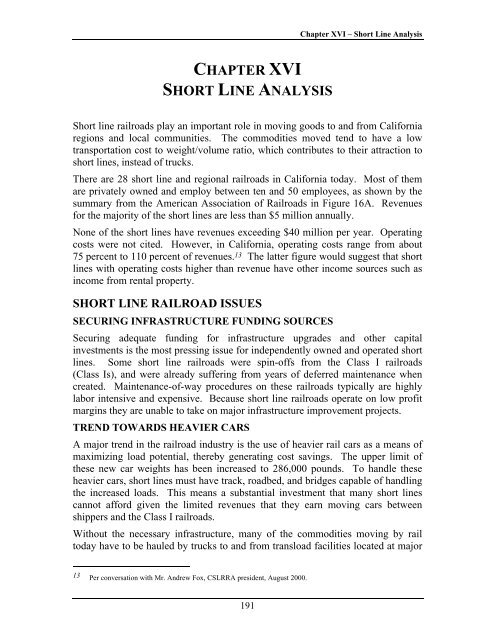California State Rail Plan 2005-06 to 2015-16
California State Rail Plan 2005-06 to 2015-16
California State Rail Plan 2005-06 to 2015-16
You also want an ePaper? Increase the reach of your titles
YUMPU automatically turns print PDFs into web optimized ePapers that Google loves.
Chapter XVI – Short Line Analysis<br />
CHAPTER XVI<br />
SHORT LINE ANALYSIS<br />
Short line railroads play an important role in moving goods <strong>to</strong> and from <strong>California</strong><br />
regions and local communities. The commodities moved tend <strong>to</strong> have a low<br />
transportation cost <strong>to</strong> weight/volume ratio, which contributes <strong>to</strong> their attraction <strong>to</strong><br />
short lines, instead of trucks.<br />
There are 28 short line and regional railroads in <strong>California</strong> <strong>to</strong>day. Most of them<br />
are privately owned and employ between ten and 50 employees, as shown by the<br />
summary from the American Association of <strong>Rail</strong>roads in Figure <strong>16</strong>A. Revenues<br />
for the majority of the short lines are less than $5 million annually.<br />
None of the short lines have revenues exceeding $40 million per year. Operating<br />
costs were not cited. However, in <strong>California</strong>, operating costs range from about<br />
75 percent <strong>to</strong> 110 percent of revenues. 13 The latter figure would suggest that short<br />
lines with operating costs higher than revenue have other income sources such as<br />
income from rental property.<br />
SHORT LINE RAILROAD ISSUES<br />
SECURING INFRASTRUCTURE FUNDING SOURCES<br />
Securing adequate funding for infrastructure upgrades and other capital<br />
investments is the most pressing issue for independently owned and operated short<br />
lines. Some short line railroads were spin-offs from the Class I railroads<br />
(Class Is), and were already suffering from years of deferred maintenance when<br />
created. Maintenance-of-way procedures on these railroads typically are highly<br />
labor intensive and expensive. Because short line railroads operate on low profit<br />
margins they are unable <strong>to</strong> take on major infrastructure improvement projects.<br />
TREND TOWARDS HEAVIER CARS<br />
A major trend in the railroad industry is the use of heavier rail cars as a means of<br />
maximizing load potential, thereby generating cost savings. The upper limit of<br />
these new car weights has been increased <strong>to</strong> 286,000 pounds. To handle these<br />
heavier cars, short lines must have track, roadbed, and bridges capable of handling<br />
the increased loads. This means a substantial investment that many short lines<br />
cannot afford given the limited revenues that they earn moving cars between<br />
shippers and the Class I railroads.<br />
Without the necessary infrastructure, many of the commodities moving by rail<br />
<strong>to</strong>day have <strong>to</strong> be hauled by trucks <strong>to</strong> and from transload facilities located at major<br />
13 Per conversation with Mr. Andrew Fox, CSLRRA president, August 2000.<br />
191













